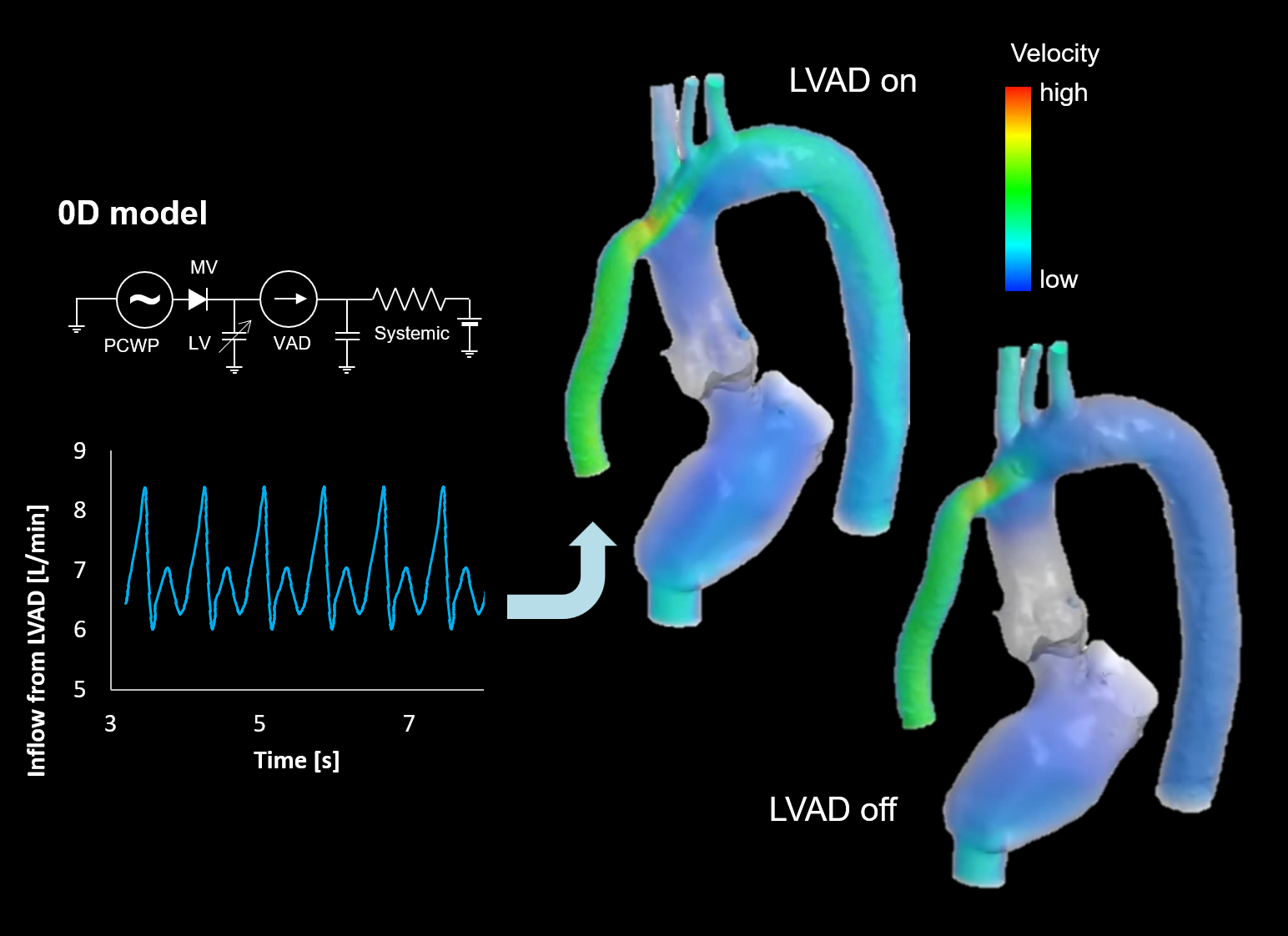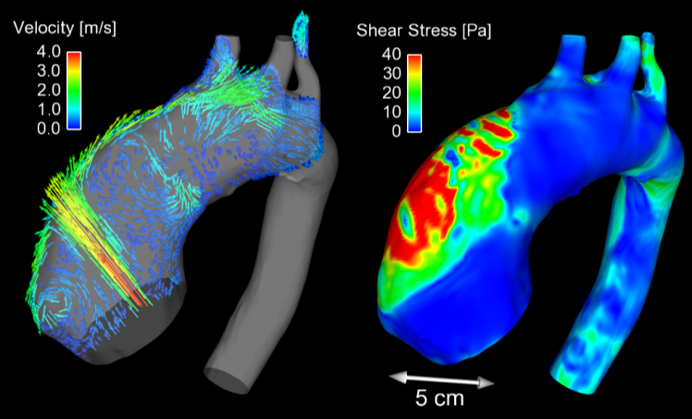Cardiac and Aortic Diseases
Aorta is the largest vessel in human body, having its diameter 2-3cm and located straight after the left ventricle. This can be considered as the beginning of systemic circulation and plays a vital role to smoothly supply the blood to whole body. There are however some major known diseases occuring in the aorta, for example ascending aortic aneurysm and Type-A aortic dissection, both of which could lead to catastrophic event such as rupture of the aorta that is life threatening. Many of these problems are associated with biomechanics, e.g. force acting on the aortic wall to understand the risk of dissection for which computational modelling could be a powerful tool since it is not possible to masure the force directly in human aorta. Additionally, to complement the important functionality of aorta and aortic valve in those who having disortder, there are a large variety of medical devices developed. Computational model is also used in design and development of such devices, since it can offer detailed quantification and visualisation of important biomechanical metrics such as shear rate in the blood stream that is closly related to blood damege (Casa et al. J Vasc Surg 61(4), 2015).
Predicting in-situ performance of Left Ventricular Assist Devices for better device operation
 Patients with advanced heart failure often require Left Ventricular Assict Devices (LVAD). LVADs were first developed as a bridging therapy to support patients having a weakened heart till the time they can have a heart transplant, but its use has been widened, sometimes used as a destination therapy (Dunlay et al. Circ: Heart Failure 9(10), 2016). The use of different types of LVAD is indeed increasing, by 1000 in 7 years before COVID-19 pandemic (Yuzefpolskaya et al. Ann Thorac Surg 115(2), 2023). LVAD is essentially a centrifugal pump, it is designed to produce a continuous flow whilst the physiological flow is pulsatile. Becuase the primary purpose of the LVAD is to supply flow and maintain blood circulation in any form, steady flow supply has been well accepted, but as the technology is established fundamentally, number of patients is increasing, and monitoring and control technology advance, a better operation of LVAD such as provision of flow pulsatility is being explored (Cheng et al. Ann Cardiothorac Surg 3(6) 2014). We tackle this challenge, with an extensive international collaboration across the Atlantic, by using an integrated framework of 3D CFD and 0D lumped paraemter model; the former to understand detailed local flow characteristics, couopled with a simplified model model of entire/global circulatory system by the latter.
Patients with advanced heart failure often require Left Ventricular Assict Devices (LVAD). LVADs were first developed as a bridging therapy to support patients having a weakened heart till the time they can have a heart transplant, but its use has been widened, sometimes used as a destination therapy (Dunlay et al. Circ: Heart Failure 9(10), 2016). The use of different types of LVAD is indeed increasing, by 1000 in 7 years before COVID-19 pandemic (Yuzefpolskaya et al. Ann Thorac Surg 115(2), 2023). LVAD is essentially a centrifugal pump, it is designed to produce a continuous flow whilst the physiological flow is pulsatile. Becuase the primary purpose of the LVAD is to supply flow and maintain blood circulation in any form, steady flow supply has been well accepted, but as the technology is established fundamentally, number of patients is increasing, and monitoring and control technology advance, a better operation of LVAD such as provision of flow pulsatility is being explored (Cheng et al. Ann Cardiothorac Surg 3(6) 2014). We tackle this challenge, with an extensive international collaboration across the Atlantic, by using an integrated framework of 3D CFD and 0D lumped paraemter model; the former to understand detailed local flow characteristics, couopled with a simplified model model of entire/global circulatory system by the latter.
Main collaborators University of Chicago, Medstar Washington Hospital Center, Barts Heart Centre, Laboratorio Nacional de Computacao Cientifica (Brazil)
- Relevant key publications:
- Grinstein et al. ASAIO Jounral 67(7), 2021.
- Grinstein et al. Frontiers in Cardiovascular Medicine, 2022.
Analysis of aortic flow in association with valve functions
 Aorta, especially aortic root "performs extremely sophisticated vital functions" that is associated with its "highly specialized structures,
change their shape and size during different parts of the cardiac cycle, and interact with each other as well as with surrounding structures" (Yacoub et al. Ann Thorac Surg, 68, 1999). Therefore, any anomalies occurring to components of aortic root/valve could have a tremendous impact on the blood circulation. Two typical examples of such anomalies are bicuspid aortic valve and valve calcification, the former is congenital present approximately in 1% of general population (Sillesen et al. JAMA 325(6), 2021) and the latter is often seen in aged population >65 years old (Ancona and Pinto. ESC e-Journal of Cardiology Practice 18, 2020). Typical mitigations include valve/root replacement, with a variety of replacement root/valve (e.g. mechanical valve, homograft, xenograft and autograft) implanted via different surgical and transcatheter techniques. We investigate the haemodynamic performance of the valves and aorta in health, disease and post-operative conditions using an approach combining in vivo imaging and computational modelling [3,4]. An example study looking at the flow in the aorta of patient having a bicuspid aortic valve is shown in the figure. Here, a strong jet through narrowed (calcified) valve, which is impinging the anterior wall of the aorta, is depicted by CFD based on geometry and boundary condition obtained from cardiovascular magnetic resonance [5]. Such a repeated impact of blood stream could affect biological activity in the wall and could have cauesd the aneurysm in this patient. These highlight how the flow and anatomy are associated, and offer opportunities to predict how the flow and other biomechanical environment may be affecting the condition of the aorta in long-term. Knowledge and understanding of the aortic biomechanics would also help the design of novel cardiac devices, which we also pursue by leveraging the experimental anc computational expertise within the department [6].
Aorta, especially aortic root "performs extremely sophisticated vital functions" that is associated with its "highly specialized structures,
change their shape and size during different parts of the cardiac cycle, and interact with each other as well as with surrounding structures" (Yacoub et al. Ann Thorac Surg, 68, 1999). Therefore, any anomalies occurring to components of aortic root/valve could have a tremendous impact on the blood circulation. Two typical examples of such anomalies are bicuspid aortic valve and valve calcification, the former is congenital present approximately in 1% of general population (Sillesen et al. JAMA 325(6), 2021) and the latter is often seen in aged population >65 years old (Ancona and Pinto. ESC e-Journal of Cardiology Practice 18, 2020). Typical mitigations include valve/root replacement, with a variety of replacement root/valve (e.g. mechanical valve, homograft, xenograft and autograft) implanted via different surgical and transcatheter techniques. We investigate the haemodynamic performance of the valves and aorta in health, disease and post-operative conditions using an approach combining in vivo imaging and computational modelling [3,4]. An example study looking at the flow in the aorta of patient having a bicuspid aortic valve is shown in the figure. Here, a strong jet through narrowed (calcified) valve, which is impinging the anterior wall of the aorta, is depicted by CFD based on geometry and boundary condition obtained from cardiovascular magnetic resonance [5]. Such a repeated impact of blood stream could affect biological activity in the wall and could have cauesd the aneurysm in this patient. These highlight how the flow and anatomy are associated, and offer opportunities to predict how the flow and other biomechanical environment may be affecting the condition of the aorta in long-term. Knowledge and understanding of the aortic biomechanics would also help the design of novel cardiac devices, which we also pursue by leveraging the experimental anc computational expertise within the department [6].
Main collaborators: Great Ormond Street Hospital, Royal Brompton Hospital, Aswan Heart Centre, UCL Cardiovascular Engineering Lab
- Relevant key publications:
- Torii et al. J Thrac Cardiovasc Surg 143(6), 2012.
- Yacoub et al. J Thrac Cardiovasc Surg 156(3), 2018.
- Torii et al. JACC: Cardiovasc Img 6(9), 2012.
- Bozkurt et al. Ann Biomed Eng 45(8), 2017.
